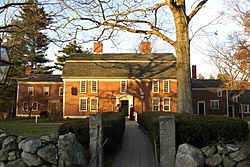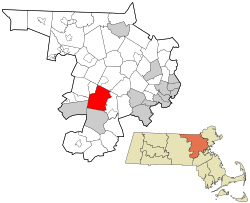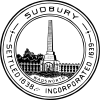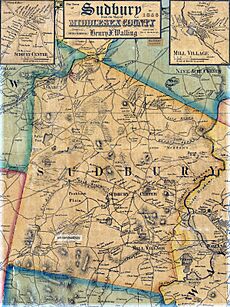Sudbury, Massachusetts facts for kids
Quick facts for kids
Sudbury, Massachusetts
|
||
|---|---|---|

Wayside Inn
|
||
|
||

Location in Middlesex County in Massachusetts
|
||
| Country | United States | |
| State | Massachusetts | |
| County | Middlesex | |
| Settled | 1638 | |
| Incorporated | 1639 | |
| Government | ||
| • Type | Open town meeting | |
| Area | ||
| • Total | 24.6 sq mi (63.8 km2) | |
| • Land | 24.4 sq mi (63.1 km2) | |
| • Water | 0.3 sq mi (0.7 km2) | |
| Elevation | 190 ft (58 m) | |
| Population
(2020)
|
||
| • Total | 18,934 | |
| • Density | 769.7/sq mi (296.77/km2) | |
| Time zone | UTC−5 (Eastern) | |
| • Summer (DST) | UTC−4 (Eastern) | |
| ZIP Code |
01776
|
|
| Area code(s) | 351 / 978 | |
| FIPS code | 25-68260 | |
| GNIS feature ID | 0618237 | |
| Website | sudbury.ma.us | |
Sudbury is a town in Middlesex County, Massachusetts, United States. It is part of the Greater Boston area, in a region called MetroWest. In 2020, about 18,934 people lived there. Sudbury has a long history, dating back to colonial times.
Contents
History of Sudbury
Early Days and Native Americans
Sudbury became an official town in 1639. Its original borders were much larger than today. They included areas that are now Wayland, and parts of Framingham, Marlborough, Stow, and Maynard.
Before European settlers arrived, Nipmuc Native Americans lived in this area. A medicine man named Tantamous and his son Peter Jethro were among them. In 1684, Peter Jethro sold a large piece of land to Sudbury for settlement.
Town Center and Important Buildings
The first town center and meetinghouse were near the Sudbury River. This area is now Wayland's North Cemetery. Crossing the river was hard in winter. Everyone had to attend church and town meetings.
So, in 1723, a new meetinghouse was built west of the river. This spot is now the main Town Center. It was used for both church services and town meetings. The church and town government separated in 1836. A new Town House was built in 1846. This building burned down in 1930. The current Town Hall was built in 1932. The Sudbury Center Historic District still looks much like it did long ago.
Sudbury's Role in Wars
Sudbury played an important part in early American history. During King Philip's War, Sudbury sent the most local soldiers to fight. The town was also the site of a famous attack on Sudbury. Ephraim Curtis, a successful leader from West Sudbury, has a junior high school named after him.
Sudbury soldiers also fought in the battles of Lexington and Concord in 1775. They fired at British Army troops returning to Boston.
The Famous Wayside Inn
One of Sudbury's most famous places is the Wayside Inn. It claims to be the oldest operating inn in the country. The Howe family owned and ran it for many years.
The famous poet Henry Wadsworth Longfellow wrote a book of poems called Tales of a Wayside Inn in 1863. In this book, a poem called The Landlord's Tale contains the well-known line, "listen my children and you shall hear, of the midnight ride of Paul Revere."
Later, Henry Ford, who founded the Ford Motor Company, bought the inn in 1923. He fixed it up and gave it to a charity. The inn still operates today. Ford also built a boys' school, a grist mill, and the Martha-Mary Chapel on the property. He even moved the Redstone Schoolhouse from Sterling to the inn. This school was believed to be where the nursery rhyme Mary Had a Little Lamb took place.
Growth and Modern Times
After World War II, Sudbury grew very quickly. Many people moved there, and new businesses started. Companies like Raytheon and Sperry Rand were big employers. In the 1970s, many engineers working on early computers lived in Sudbury. The town was also known for growing many carnations in greenhouses.
In the 1920s, there was a conflict at a Sudbury farm. Police arrested many people involved. After this, officials made it harder for such groups to meet, and the conflict ended.
Sudbury has worked to protect its natural areas. Large parts of the town, especially in the north, have been kept as open space. This includes wetlands and areas along the Hop Brook. A big part of the Assabet River National Wildlife Refuge is also in Sudbury.
Geography of Sudbury
Sudbury covers about 24.6 square miles (63.8 square kilometers). Most of this area is land, with a small part being water. The highest point in Sudbury is on the north side of Nobscot Hill. The very top of the highest hill is called Tippling Rock.
In 1650, the town of Sudbury was much larger. It included the areas that are now Wayland and Maynard.
Population and People
| Historical population | ||
|---|---|---|
| Year | Pop. | ±% |
| 1790 | 1,290 | — |
| 1800 | 1,303 | +1.0% |
| 1810 | 1,287 | −1.2% |
| 1820 | 1,417 | +10.1% |
| 1830 | 1,423 | +0.4% |
| 1840 | 1,422 | −0.1% |
| 1850 | 1,578 | +11.0% |
| 1860 | 1,691 | +7.2% |
| 1870 | 2,091 | +23.7% |
| 1880 | 1,178 | −43.7% |
| 1890 | 1,197 | +1.6% |
| 1900 | 1,150 | −3.9% |
| 1910 | 1,120 | −2.6% |
| 1920 | 1,121 | +0.1% |
| 1930 | 1,182 | +5.4% |
| 1940 | 1,754 | +48.4% |
| 1950 | 2,596 | +48.0% |
| 1960 | 7,447 | +186.9% |
| 1970 | 13,506 | +81.4% |
| 1980 | 14,027 | +3.9% |
| 1990 | 14,358 | +2.4% |
| 2000 | 16,841 | +17.3% |
| 2010 | 17,659 | +4.9% |
| 2020 | 18,934 | +7.2% |
| 2023* | 19,394 | +2.4% |
| * population 1850–2010 Source: United States Census records and Population Estimates Program data. * population 1790–1840 Source: Map Of Massachusetts |
||
As of the year 2000, there were about 16,841 people living in Sudbury. There were 5,504 households, and 4,749 families. About half of the households (51.1%) had children under 18 living with them. Most families (78.5%) were married couples.
The average household had about 3 people, and the average family had about 3.28 people. About 32.5% of the population was under 18 years old. The median age in the town was 39 years.
Arts and Culture in Sudbury
The First Parish of Sudbury church started in 1640. It was first located east of the Sudbury River, in what is now Wayland. Later, the "West parish" moved to the current Sudbury town center in 1722. The historic meeting house you see today was built in 1797. It replaced the older building from 1723.
Education in Sudbury
Students in Sudbury from kindergarten through eighth grade go to schools run by Sudbury Public Schools. For high school, students attend the Lincoln-Sudbury Regional School District. This district was created in 1954, combining the high schools of Sudbury and the nearby town of Lincoln.
In 2002, Lincoln and Sudbury worked together to build a new high school. The shared Lincoln-Sudbury Regional High School (LSRHS) is located in Sudbury.
Sudbury has four elementary schools:
- Josiah Haynes Elementary School
- Israel Loring Elementary School
- General John Nixon Elementary School
- Peter Noyes Elementary School
The middle school is:
- Ephraim Curtis Middle School
Two former elementary schools in Sudbury have been changed for other uses:
- Fairbank Elementary School is now a community center and the main office for the school district.
- Horse Pond Elementary School is now a Massachusetts State Police Crime Laboratory.
Notable People from Sudbury
Many interesting people have lived in Sudbury, including:
- Chris Evans, a famous actor.
- Scott Evans, also an actor and Chris's brother.
- Henry Ford, the founder of the Ford Motor Company, lived here for parts of the 1920s and 1930s.
- Mike Gordon, the bassist for the band Phish.
- Michelle Gorgone, an Olympic snowboarder.
- Edward Hallowell, a psychiatrist and author.
- Eddie House, an NBA champion with the Boston Celtics.
- Tyler Jewell, an Olympic snowboarder.
- John Nixon, a General in the Continental Army during the American Revolution.
- Shaquille O'Neal, a famous NBA champion and Hall of Famer, lived in Sudbury for a short time.
- Paula Poundstone, a comedian who grew up in Sudbury.
- Babe Ruth, a baseball Hall of Famer, rented a house here during an off-season.
- Simon Shnapir, an Olympic medalist in pair skating.
- Jeremy Strong, an actor who won an Emmy Award for his role in Succession.
- Callie Thorne, an actress from the TV series Rescue Me.
See also
 In Spanish: Sudbury (Massachusetts) para niños
In Spanish: Sudbury (Massachusetts) para niños




